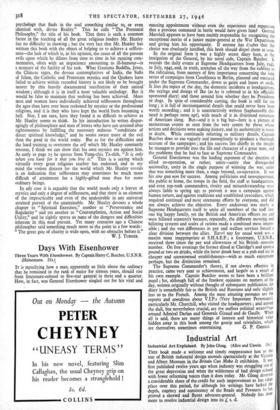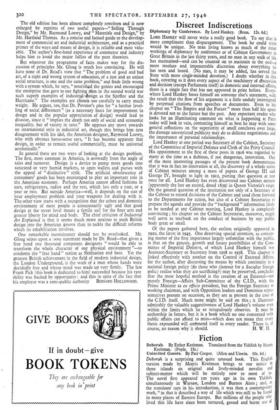Industrial Art
Industrial Art Explained. By John Gloag. (Allen and Unwin. 15s..
Tins book made -a welcome and timely reappearance just as the star of British industrial design ascends spectacularly at the Victoria and Albert Museum in the Britain Can Make It exhibition. It was first published twelve years ago when industry was struggling out of the great depression and when the wilderness of bad design echoed with fewer reforming voices than it does today. Mr. Gloag deserves a considerable share of the credit for such improvement as has taken place over this period, for although his writings have lacked the depth, cogency and consistency of the Reads and Pevsners he has proved a shrewd and fluent advocate-general. Nobody has done more to resolve industrial design into its £ s. d.
The old edition has been almost completely rewritten and is now enlarged by reprints of two useful papers—" Selling Through
Design," by Mr. Raymond Loewy, and " Materials and Design," by Mr. Hartland Thomas. As a concise and factual guide to the develop- ment of commercial art and industrial .architecture, and as a practical
primer of the ways and means of design, it is reliable and most valu- able. The author's first-hand experience of commerce and industry helps, him to 'avoid the major follies of the pure theorists.
But wherever the programme of facts makes way for the dis- cussion of principles Mr. Gloag is much less convincing. He will have none of Dr. Read's view that " The problem of good and bad art, of a right and wrong system of education, of a just and an unjust social structure, is one and the same problem," and finds little wrong with a system which, he says, " nourished the genius and encouraged the enterprise that gave to our fighting Arlen in the second world war such superb examples of industrial'4esign as the Spitfire and the Hurricane." The examples are cifosen too carefully to carry much weight. He argues, too, that Dr. Pevsner's plea for " a further level- ling of social differences " (as a necessary basis for improvement in design and in the popular appreciation of design) would lead to disaster, since it " implies the death not only of social and economic inequality, but of variety in taste." He opposes any move towards an international style in industrial art, though this brings him into disagreement with his idol, the American designer, Raymond Loewy, who with obvious horse-sense says, " It has become apparent that design, in order to remain useful commercially, must be universal aesthetically."
In general there are two ways of looking at the design problem. The first, most common in America, is avowedly from the angle of sales and turnover. Design is a device to pump more goods into saturated or very humid markets, to open wallets and purses with the appeal of " distinctive " style. The artificial obsolescence of consumers' goods has been encouraged to play an important role in the American economy. Perhaps America cannot afford fashions in cars, refrigerators, radios and the rest, which last only a year, or a year or two. But outside America—well, it depends on the size of your employment problem and your weapons for dealing with it. The other view starts with a recognition that the urban and domestic environment of most people is unnecessarily ugly and that good design at the street level means a fertile soil for the finer arts and greater liberty for mind and body. The chief criticism of Industrial Art Explained is that it seems much more anxious to push British design into the American groove than to tackle the difficult reforms which its rehabilitation involves.
One remarkable inconsistency should not be overlooked. Mr. Gloag seizes upon a i pose statement made by Dr. Read—that given a free hand one thousand competent designers " would be able to transform the whole character of our physical environment "—to condemn the " free hand " notion as totalitarian and base. Yet the greatest British achievement in the field of modern industrial design, the London Underground, is the work of a man whose hands were decidedly free and whose mind was made up very firmly. The late Frank Pick (this book is dedicated to him) succeeded because his rare ability was backed by opportunity : and this in spite of the fact that his employer was a semi-public authority BERNARD HOLLOWOOD.



























 Previous page
Previous page